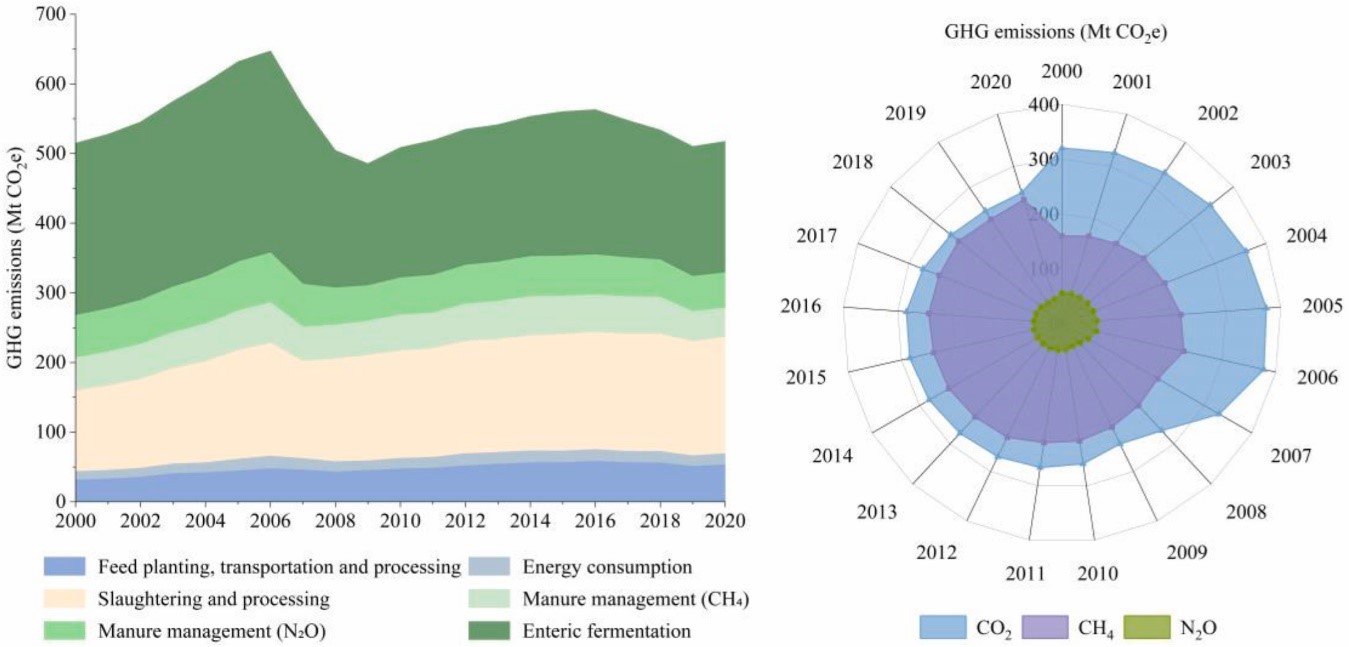December 15, 2023 | Journal of Environmental Management | Source |
Introduction:
Livestock production is a significant source of greenhouse gas emissions (GHGE) in China, challenging the country’s 2030 carbon peaking and 2060 neutrality goals. Researchers from Hubei University and the Chinese Academy of Sciences used life cycle assessment (LCA), logarithmic mean Divisia index (LMDI) to analyze the influence of efficiency, structure, economy, and population size on GHGE, and STIRPAT modeling to analyze historical GHGE trends from 2000 to 2020 across 31 provinces and forecast emissions under 5 Shared Socioeconomic Pathways (SSPs) through 2060.
Key findings:
Using LCA, the study found that from 2000 to 2020, livestock-related GHGE in China remained relatively stable, decreasing slightly from 535.5 to 532.2 Mt COâ‚‚e. However, the emission profile shifted: methane (CHâ‚„) from enteric fermentation, though still the largest source, dropped from 50% to 38% of total emissions, while COâ‚‚ emissions from feed production and processing rose by over 70%. Emission intensity (GHGE per unit of GDP) declined across all provinces, with the steepest reductions in South China. Applying the LMDI, the study revealed that economic growth was the primary driver of emission increases, especially in provinces like Shandong and Henan, where economic factors added over 40 Mt COâ‚‚e. In contrast, gains in production efficiency—through improved feed, livestock breeds, and mechanization—helped reduce emissions, particularly in the south. Structural and labor factors had smaller and more variable effects.
Projections using the STIRPAT model with SSPs suggest that under SSP1 (sustainability) and SSP2 (middle of the road), emissions will peak by 2030 and fall to 282.0 and 352.1 Mt COâ‚‚e, respectively, by 2060. Under SSP5 (fossil-fueled development), emissions could rise to 667.8 Mt COâ‚‚e. Northeast and Southwest China are likely to become future emission hotspots due to livestock expansion policies.To meet the country’s climate goals, the study recommends: (1) improving feed and digestibility to cut CHâ‚„, (2) optimizing the spatial layout of livestock systems, (3) promoting crop-livestock integration to enhance resource efficiency by reusing waste, and (4) encouraging dietary shifts toward plant-based foods. Further research is needed on system-level differences and consumer-driven emissions.

Figure | Structure of greenhouse gas emissions (GHGE) in the life cycle of livestock from 2000 to 2020.





